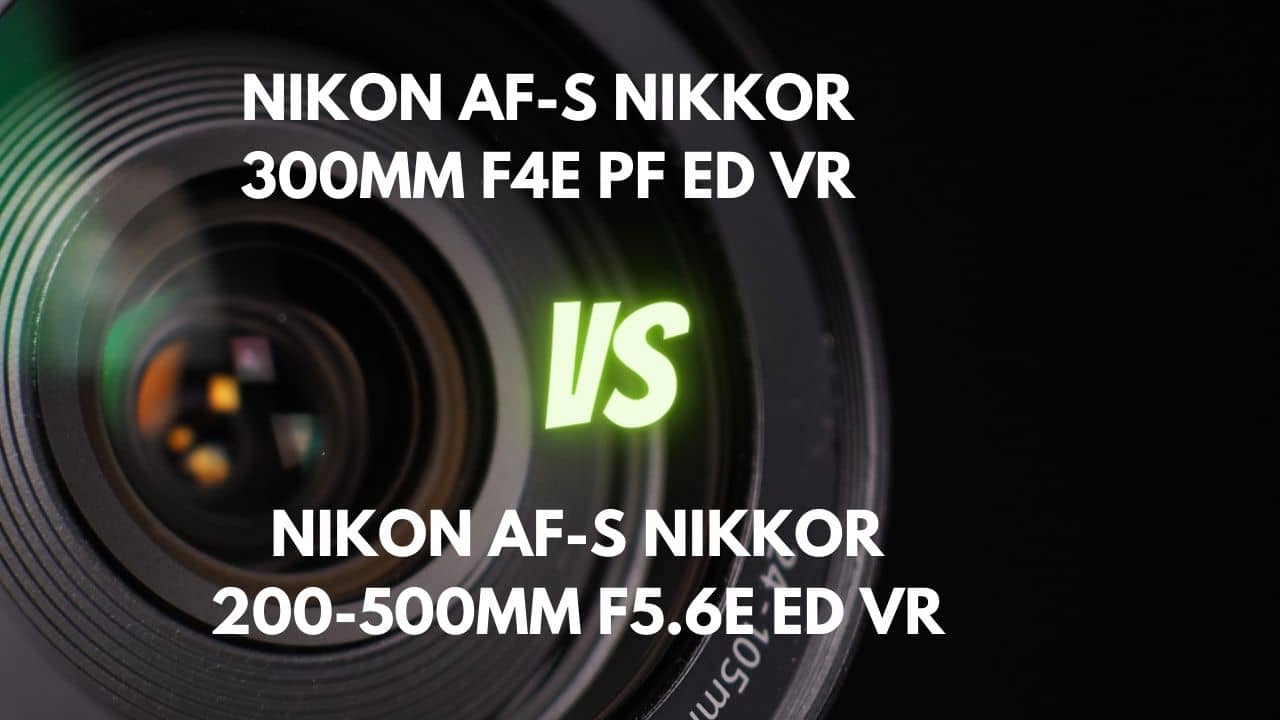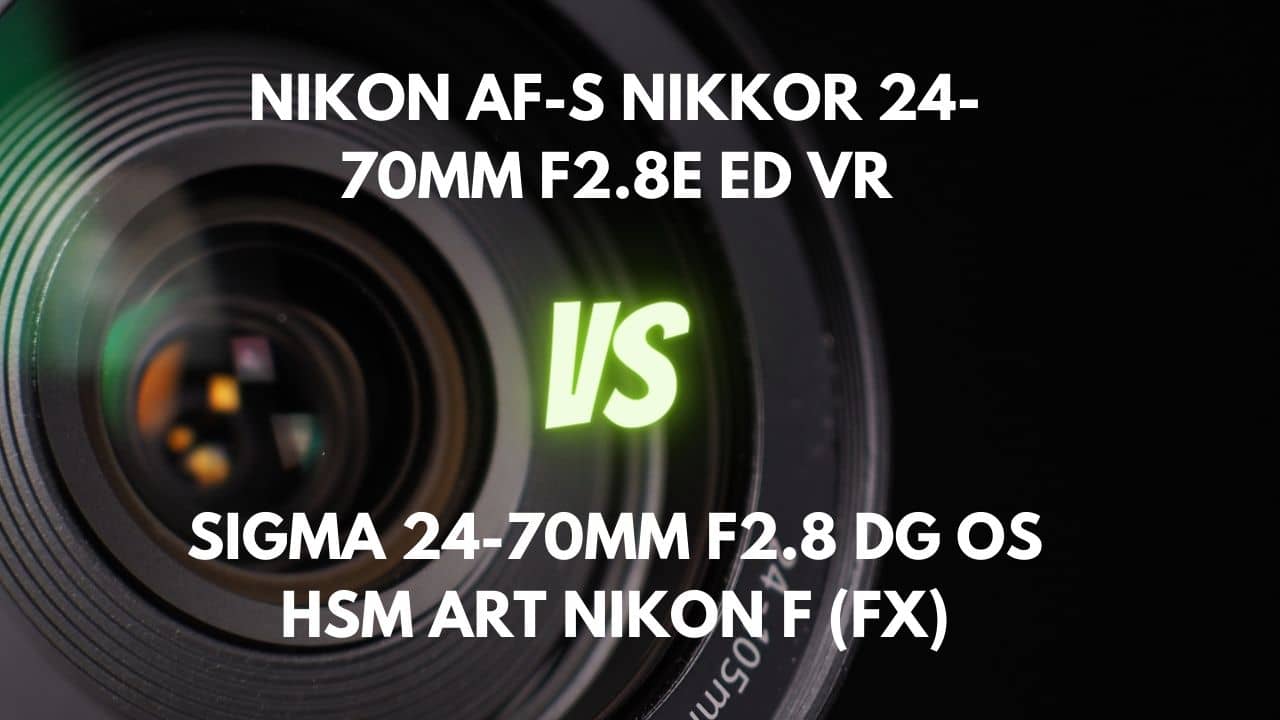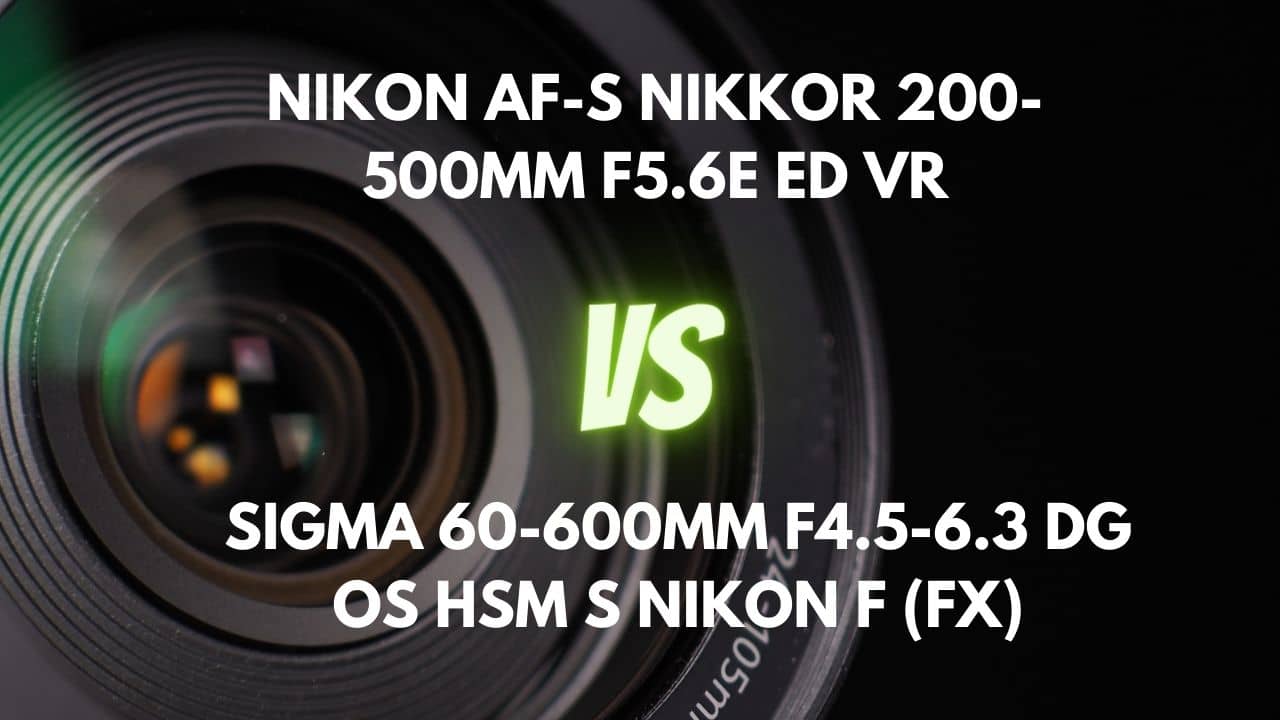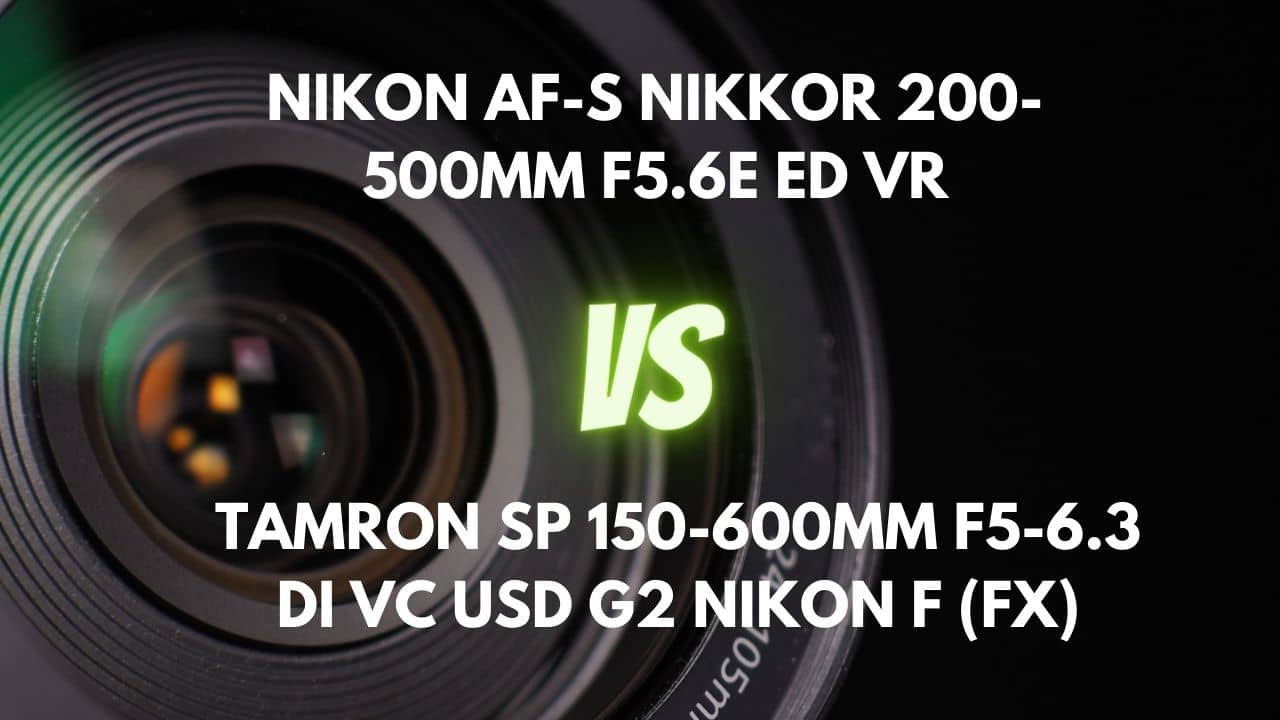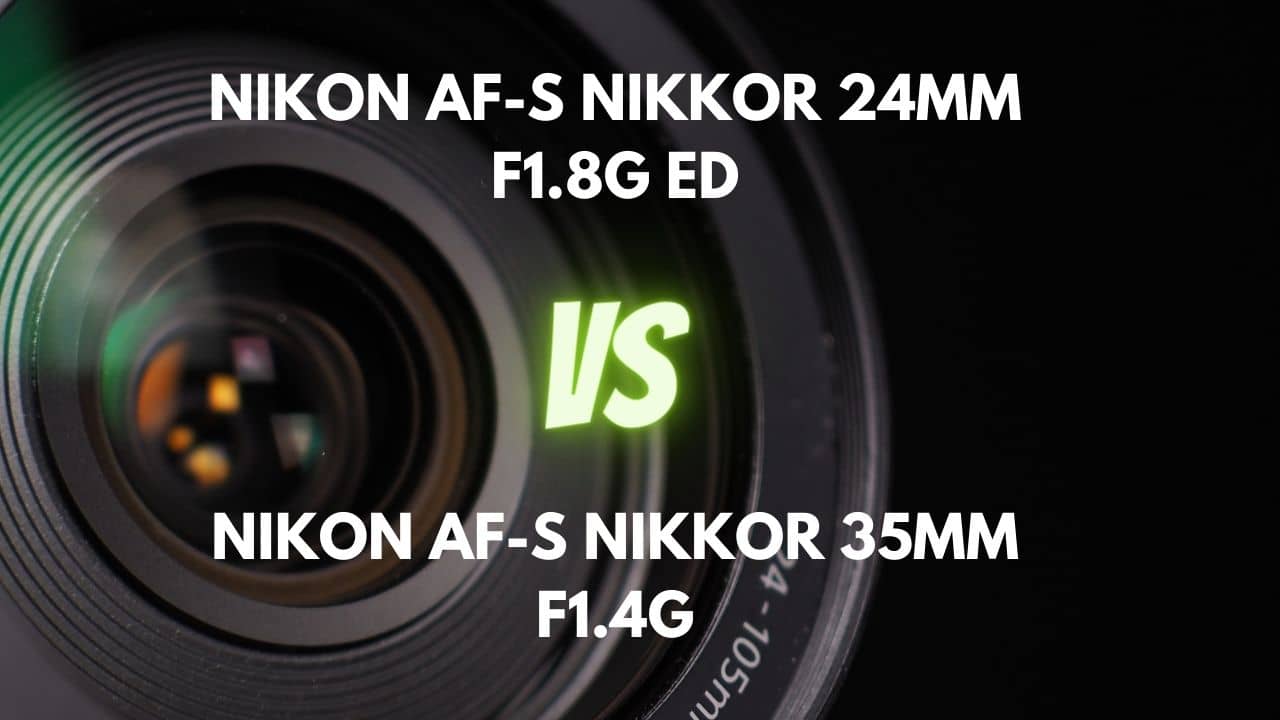As a passionate photographer, you’ve undoubtedly found yourself in the thrilling yet perplexing world of telephoto lenses. Whether you’re capturing high-speed sports, elusive wildlife, or intimate portraits, a powerful and versatile telephoto lens is an indispensable tool in your photography arsenal. But with so many options available, how do you choose the perfect lens to match your creative vision and budget? Enter the great telephoto lens showdown: the Nikon AF-S NIKKOR 120-300mm F2.8E FL ED SR VR vs. the Sigma APO 120-300mm F2.8 EX DG OS HSM Nikon F (FX).
In this epic battle of glass and metal, we’ll delve into the nuances and use cases of these two powerhouse lenses, exploring their strengths, weaknesses, and everything in between. You’ll learn how the Nikon lens flexes its optical muscle with exceptional sharpness, beautiful bokeh, and impressive aberration control. At the same time, the Sigma lens holds its own as a budget-friendly contender with solid image quality, compact design, and commendable performance in various aspects.
Let’s begin!
Overview
| Nikon AF-S NIKKOR 120-300mm F2.8E FL ED SR VR | Sigma APO 120-300mm F2.8 EX DG OS HSM Nikon F (FX) | |
|---|---|---|
| Max Aperture | F2.8 | F2.8 |
| Aperture Type | Fixed | Fixed |
| Focal Range (mm) | 120-300 | 120-300 |
| Max Format | 35mm FF | 35mm FF |
Let’s embark on an exciting journey to explore and compare the Nikon 120-300 f/2.8 and the Sigma 120-300 f/2.8!
Both lenses feature a maximum aperture of f/2.8, which ensures bright images and excellent low-light performance. These fixed aperture lenses maintain the same maximum aperture throughout the entire focal range, providing consistent image quality and exposure. This also allows for faster shutter speeds or lower ISO settings, resulting in cleaner and sharper images.
The focal range for both lenses is 120-300mm, offering flexibility and versatility to capture a wide variety of subjects. This range is especially suitable for sports, wildlife, and portrait photography, where the ability to zoom in on your subject is crucial.
The maximum format for both lenses is 35mm full-frame (FF), which means they are compatible with high-resolution full-frame cameras, offering outstanding image quality and detail.
Design and Ease of Use
| Nikon AF-S NIKKOR 120-300mm F2.8E FL ED SR VR | Sigma APO 120-300mm F2.8 EX DG OS HSM Nikon F (FX) | |
|---|---|---|
| Diameter x Length (mm) | ⌀128×303.5mm | ⌀114×289mm |
| Weight (gr) | 3250 | 2950 |
| Filter Thread (mm) | 112 | 105 |
| Weather Sealing | Yes | Yes |
| Zoom Method | Rotary (internal) | Rotary (internal) |
| Zoom Lock | No Zoom | No |
| Distance Scale | Yes | Yes |
| DoF Scale | No | No |
| Hood Supplied | Yes | Yes |
| Tripod Collar | Yes | Yes |
The Nikon 120-300 f/2.8 is a larger and heavier lens, with dimensions of ⌀128×303.5mm and a weight of 3250g. This might make it a bit more challenging to carry around, handle, and store. However, its size and weight contribute to an overall sense of sturdiness and durability. This lens also features an internal rotary zoom mechanism, which means that it doesn’t change size when you zoom in or out, resulting in a consistent camera balance and better weather sealing.
On the other hand, the Sigma 120-300 f/2.8 is a more compact and lightweight option, with dimensions of ⌀114×289mm and a weight of 2950g. This makes it easier to carry, handle, and store, and could be less tiring during longer shoots. Like the Nikon, the Sigma also features an internal rotary zoom mechanism, offering the same benefits in terms of balance and weather sealing.
Lens Mount and Barrel
The lens mount of Nikon 120-300 f/2.8 is a sophisticated bayonet mount featuring both hard rubber and foamed rubber gaskets, ensuring impressive weather resistance. The presence of spacing shims and a grounding wire on the underside of the bayonet enhance its durability. With an internally focusing design, this lens mount eliminates telescoping when zooming, preventing moisture, air, and particulates from entering the lens. In contrast, the lens mount of Sigma 120-300 f/2.8 is crafted from sturdy, high-quality metal with a rubber gasket that provides weather sealing and protection against moisture and dust.
As for the lens barrels, the Nikon lens barrel is constructed from a resilient metal alloy, featuring a design typical of Nikon’s latest big lenses. The zoom ring is near the distal end, and the focus ring is closer to the camera body. Heavy-duty eccentric adjustment collars, sealing with rubber and asphalt, and tension springs around the upper part of the mid barrel area ensure smooth operation. On the other hand, the Sigma lens barrel boasts Sigma’s new global vision polycarbonate material, offering a durable and stylish finish. The ergonomic bevel of the lens is comfortable to hold but may be too heavy for extended handheld use. It also features a 105mm front element.
In the battle of the lens mounts and barrels, the Nikon lens emerges victorious with its advanced weather-resistant design and sturdy metal barrel construction. The Sigma lens, however, still offers quality materials and craftsmanship, making it a worthy contender.
Weather Sealing
The Nikon 120-300 f/2.8 is a fortress against dust and moisture, featuring both foamed and hard rubber gaskets at the bayonet mount. Its ingenious filter ring design allows for easy replacement if damage occurs. Further reinforcements include internal seals at the rings, switches, and front of the barrel. To top it all off, a fluorine coating on the front element repels dust and dirt like a charm.
On the other side of the spectrum, the Sigma lens stands tall as a weather-sealed warrior, shielding itself from rain and dust. Internal seals at the rings, switches, and front of the barrel enhance its protective prowess.
While both lenses provide commendable protection against the elements, the Nikon 120-300 f/2.8 takes the throne with its added fluorine coating on the front element and the innovative filter ring design. This extra line of defense makes it the ultimate choice for photographers seeking superior weather sealing performance.
Rings
The Nikon 120-300 f/2.8 boasts 2 rings—a zoom ring and a focus ring. The zoom ring, situated near the lens’s distal end, is smooth and user-friendly, providing granular control and precise adjustments. The focus ring, closer to the camera body, features a focus scale and distance markings for easy switching between focus ranges.
Both rings exude quality with their impeccable design and materials, free from any cheap or plasticky feel. While lacking a windowed distance scale or depth-of-field indicator on the focus ring, the lens does include a focus limiter. The firm yet smooth zoom ring prevents accidental adjustments, while the internal focusing system prevents moisture, air, or particulates from entering the lens.
On the other hand, the Sigma lens offers a zoom ring and a focus ring. The zoom ring, positioned towards the front, starts at 120mm and progresses to 300mm, providing a stiff but smooth rotation that prevents accidental changes in focal length. The focus ring, located at the back of the lens, is smooth and precise, making it ideal for video work.
The Nikon 120-300 f/2.8 takes the lead with its perfect balance of firmness and smoothness, precise control, and superior build quality. The innovative internal focusing system further solidifies its position as the superior lens.
Switches/Buttons
Delve into the world of switches and buttons on the Nikon 120-300 f/2.8 and Sigma 120-300 f/2.8, where functionality and customization merge with ease.
The Nikon lens is adorned with numerous switches and buttons, such as the AF/MF switch for toggling between autofocus and manual focus modes, focus function buttons for programming new functions, and VR controls with a 3-position button for various VR modes.
Additional features include memory recall, AF-ON, and a switch to silence the beep during memory recall focus. Typical of Nikon’s latest big lenses, the zoom ring is situated near the distal end, and the focus ring closer to the camera body, with all buttons and controls even nearer to the camera body.
On the other hand, the Sigma lens is equipped with an AF/MF switch, a focus limit switch to choose between 10mm to infinity or 0 to 10 meters, and two levels of image stabilization. A unique custom function switch can be set and saved using the Sigma USB dock, enabling personalized settings like focus speed and accuracy priority.
The Nikon lens takes the crown with its comprehensive array of switches and buttons, providing photographers with unmatched flexibility and control.
Filter Thread
Equipped with a 112mm front filter thread, the Nikon 120-300 f/2.8 offers a twist-in filter system, letting you use polarizers and other filters with ease. If your filter ring suffers damage, no worries; this lens boasts a simple replacement process, complete with a thick foamed sealant.
On the other hand, the Sigma 120-300 f/2.8 lens showcases a 105mm filter thread. Although large and requiring a more significant investment in filters, this lens ensures the filter thread remains stationary during focus. Drop-in filters may be absent, but with the right equipment, filtering your shots is still achievable.
In the realm of filter threads, Nikon emerges as the superior choice due to its innovative twist-in filter system and user-friendly filter ring replacement. However, both lenses are capable of enhancing your photography experience, so let your creative instincts guide your decision.
Lens Hood
With the Nikon 120-300 f/2.8 lens, you’ll find a 6-inch diameter hood with a 4.5-inch depth, crafted from the same lightweight material as the renowned HK-41 hood. Keep in mind, though, replacing it can be costly if it gets damaged.
The lens hood of Sigma 120-300 f/2.8, however, boasts a rugged polycarbonate construction and impressive weather-sealing. This sturdy hood feels like it could survive a ten-foot drop and still protect your lens from the elements. It’s compatible with the Sigma Global Vision, and although it requires a set screw, its rotation is smooth and rubberized on the inside.
In the battle of the lens hoods, the Sigma’s durable construction and weather-sealing make it the superior choice. While both hoods offer protection and functionality, the Sigma hood’s robust design ensures your lens remains safeguarded in even the most challenging conditions.
Tripod Collar
Nikon’s tripod collar comes permanently attached to the lens barrel, offering stability and convenience. However, the stock foot isn’t Arca-Swiss compatible, but fear not! With a small Phillips screwdriver, you can easily replace it with a third-party tripod foot that is Arca-Swiss compatible.
On the other hand, Sigma’s lens features a well-built and durable tripod collar ring that is natively Arca-Swiss compatible. While it might be stiff initially, it can be easily adjusted and removed as needed. Although the lens is a hefty 7.5 pounds, the tripod collar is an essential accessory for photographers looking to shoot without fatigue during extended sessions.
In this tripod collar showdown, the Sigma lens emerges as the winner due to its native Arca-Swiss compatibility and easily adjustable design. While both collars provide stability, Sigma’s compatibility and user-friendly adjustments make it the superior choice for photographers who value convenience and versatility.
Focusing and Optical Stabilization
| Nikon AF-S NIKKOR 120-300mm F2.8E FL ED SR VR | Sigma APO 120-300mm F2.8 EX DG OS HSM Nikon F (FX) | |
|---|---|---|
| Autofocus | Yes | Yes |
| AF Motor | Silent Wave Motor | Hyper Sonic Motor |
| Rotating Front Element | Does not rotate on focusing | Yes |
| Min Focus Distance | 2m | 2.5m |
| Max Magnification (X) | 0.16 | 0.13 |
| Full-Time Manual Focus | Yes | Yes |
| Focus Method | Internal | Internal |
Focusing Performance
Starting with the Nikon 120-300 f/2.8, you’ll experience lightning-fast focus acquisition, perfect for capturing fast-moving subjects even in low-light situations. The autofocus system is silent and efficient, locking onto targets effortlessly. With an internally focusing design, the lens maintains a constant length regardless of focus and zoom settings. Plus, the manual focus override offers a smooth and seamless experience, and the front element stays still during focusing.
On the other hand, the Sigma 120-300 f/2.8 showcases a quiet autofocus motor with remarkable accuracy. Although it may not be as fast as Canon’s ultrasonic lenses, you can switch to focus speed priority via the Sigma dock to boost AF speed with a slight compromise in focus accuracy.
Tracking moving subjects is a breeze, and the internally focusing design keeps the lens length constant. Smooth manual focus action, manual focus override, and the ability to fine-tune focusing using a Sigma USB dock make this lens a powerful contender. In low-light situations, the f/2.8 maximum aperture ensures excellent performance.
In this battle of focusing performance, the Nikon lens emerges as the victor, thanks to its lightning-fast autofocus and silent operation. While both lenses deliver impressive results, the Nikon’s exceptional speed and accuracy make it the ultimate choice for photographers who require top-notch focusing performance in various conditions.
Optical Stabilization
The Nikon 120-300 f/2.8 is equipped with Vibration Reduction (VR), providing 4 stops of compensation against camera shake. You can choose between two VR modes: VR Normal, which delivers maximum stabilization by taming moderate vertical and horizontal vibrations, and VR Sport, which excels in high-speed burst shooting. With a focus range limiter, you can customize the distance the lens will travel. The quiet and effective VR system enables you to hand-hold the lens at slow shutter speeds.
Meanwhile, the Sigma 120-300 f/2.8 boasts optical stabilization that lets you shoot handheld in low-light situations, with 4 stops slower shutter speeds than normal without a tripod. The optical stabilizer also includes a panning mode alongside full OS for multi-directional stabilization. Quiet and efficient, this lens offers 2 image stabilization options: one for overall stabilization and another for left-to-right y-axis stabilization.
In the world of optical stabilization, the Nikon lens edges out its Sigma counterpart with its versatile VR Normal and VR Sport modes, providing greater control and flexibility to photographers. Both lenses deliver impressive stabilization, but Nikon’s tailored modes give it the upper hand for capturing sharp, steady shots in a wider range of situations.
Image Quality
| Nikon AF-S NIKKOR 120-300mm F2.8E FL ED SR VR | Sigma APO 120-300mm F2.8 EX DG OS HSM Nikon F (FX) | |
|---|---|---|
| Special Elements | Fluorine and Nano Crystal coatings | 2 FLD elements 1 SLD element |
| Diaphragm Blades | 9 | 9 |
Aberration
When it comes to aberration control, the Nikon 120-300 f/2.8 and Sigma 120-300 f/2.8 are exceptional performers, ensuring that your images remain vivid and distortion-free.
The Nikon lens boasts virtually no chromatic aberration at any focal length or aperture, as evidenced by its fringing score measurement. With its extraordinary optical quality, professional-grade output is achieved at all test distances, resulting in minimal or negligible aberrations. Advanced technologies, such as Short Wavelength Refractive (SR) and Fluorite (FL) lens elements, further reduce chromatic aberration while enhancing overall sharpness.
On the other hand, the Sigma lens delivers impressive chromatic aberration control, with any visible aberration being eliminated when stopped down to f/4 or f/5.6.
In conclusion, the Nikon lens takes the lead in aberration control with its virtually flawless performance and advanced technologies that minimize chromatic aberration and boost sharpness. While the Sigma lens also exhibits commendable aberration control, the Nikon lens stands out for delivering exceptional image quality across a range of focal lengths and apertures.
Sharpness
In the realm of sharpness, both the Nikon 120-300 f/2.8 and Sigma 120-300 f/2.8 exhibit impressive performance.
The Nikon lens delivers exceptional sharpness, particularly in the central region, maintaining consistency across the entire focal range and all apertures. While corner sharpness is slightly less impressive, it remains remarkable for a telephoto zoom lens. It demonstrates full Aperture Independent Sharpness (AIS) at all distances, with outstanding sharpness at wide open apertures. The sharpest aperture varies, but the difference between f2.8 and f3.2 is hardly noticeable.
The Sigma lens also offers impressive sharpness, especially in the image’s center, with good colors and contrast. While corners might be slightly softer, they remain very impressive. Stopping down to f/4 and f/5.6 results in excellent image quality in the corners. At 300 millimeters with the aperture wide open at f/2.8, the center is quite sharp, while the corners are good. The lens performs decently without teleconverters; however, using one may cause a loss of sharpness.
In conclusion, while both lenses boast impressive sharpness, the Nikon 120-300mm f2.8E emerges as the superior choice due to its consistent sharpness across the entire focal range and apertures. The Sigma lens offers commendable performance, especially considering its price range, but the Nikon lens’s extraordinary sharpness solidifies its position as the superior option for photographers seeking top-notch image quality.
Bokeh Quality
When examining the bokeh quality of the Nikon 120-300 f/2.8 and Sigma 120-300 f/2.8, both lenses are capable of producing pleasing out-of-focus areas.
The Nikon lens is praised for its beautiful and pleasing bokeh, consistently delivering outstanding performance in the f2.8 to f3.5 range. This lens can create dreamy background blur, enhancing the subject’s isolation and overall visual appeal in your images.
On the other hand, the Sigma lens offers reasonably nice bokeh throughout its usage, effectively melting away the background without any distracting concentric circles. This results in a smooth and beautiful bokeh. However, while the bokeh is good, it doesn’t quite reach the level of greatness.
In conclusion, both lenses deliver satisfying bokeh, but the Nikon lens has the edge in terms of bokeh quality, with its consistently beautiful and pleasing out-of-focus areas. The Sigma lens provides a good bokeh, but for those seeking the finest bokeh performance, the Nikon lens is the superior choice.
Flare/Ghosting
When comparing the flare and ghosting performance of the Nikon 120-300 f/2.8 and Sigma 120-300 f/2.8, each lens has its own approach to handling these optical issues.
The Nikon lens employs multiple coatings, including Nano Crystal, ARNEO, fluorine, and Super Integrated Coating, to combat ghosting and flare caused by diagonal light sources, internal reflections, and backlighting. These advanced coatings ensure that images remain sharp and clear, even in challenging lighting conditions, providing excellent protection against unwanted reflections.
In contrast, the Sigma lens features a coating that does a commendable job at controlling typical flare elements. However, the lens hood may not be enough to prevent contrast loss in certain situations. Despite this, shooting in RAW format allows for easy recovery of lost information during post-processing, and can even add an artistic fog-like effect to the image. While lens flare and ghosting can be an issue, the right techniques can help manage these effects.
In conclusion, the Nikon lens offers superior flare and ghosting control, thanks to its advanced coatings and technology. Although the Sigma lens may experience some contrast loss, it can still deliver impressive results when combined with the appropriate post-processing techniques. Overall, the Nikon lens has the advantage in managing flare and ghosting, providing a better performance in challenging lighting conditions.
Vignetting
When comparing the vignetting performance of the Nikon 120-300 f/2.8 and Sigma 120-300 f/2.8, both lenses exhibit some vignetting, particularly when used on full-frame sensors.
The Nikon lens does display vignetting on full-frame sensors, but this is not considered a significant issue, as it can be easily corrected during post-processing. When used with a cropped (DX) sensor, the vignetting is virtually eliminated, further minimizing its impact on image quality.
On the other hand, the Sigma lens shows noticeable vignetting when used wide open at f/2.8, but this improves substantially when stopped down to f/4 and further to f/5.6. The vignetting is not a major concern on APS-C cameras, but on full-frame cameras, the corners may appear slightly darker at f/2.8.
In conclusion, both lenses exhibit some level of vignetting, with the Nikon lens having a slight edge due to its performance on cropped sensors. However, in both cases, the vignetting can be easily managed through post-processing or by stopping down the aperture. Neither lens has a significant advantage in this area, as the differences are relatively minor and can be effectively managed by the photographer.
Distortion
When examining the distortion performance of the Nikon 120-300 f/2.8 and Sigma 120-300 f/2.8, both lenses manage distortion reasonably well, with some minor differences.
The Nikon lens produces some pincushion distortion across all focal lengths, but it is consistent and never pronounced enough to be noticeable unless shooting geometric subjects. The distortion can be corrected in-camera, although it is important to note that all in-camera optical enhancements were disabled during testing to ensure a fair comparison.
In contrast, the Sigma lens exhibits mild barrel distortion at 120mm and slight pincushion distortion at 300mm. Despite these minor distortions, the lens handles distortion quite well, particularly for a fast telephoto lens.
In conclusion, both lenses perform admirably in terms of distortion control, with neither having a significant advantage over the other. The minor distortions present in both lenses can be managed through in-camera corrections or post-processing, ensuring that photographers can achieve high-quality, distortion-free images with either option.
Final Verdict
The Nikon lens is a larger, heavier, and more expensive option, but it excels in terms of optical performance, offering exceptional sharpness, beautiful bokeh, minimal chromatic aberration, and superior flare and ghosting control. Its advanced coatings, weather-resistant design, and sturdy metal barrel construction make it ideal for photographers who demand top-notch image quality and durability.
The Sigma lens is more compact, lightweight, and affordable, while still providing impressive sharpness, good bokeh, and well-controlled chromatic aberration. It offers commendable performance in various aspects such as distortion control, vignetting, and tripod collar design, making it an excellent choice for those on a tighter budget.
If budget is not a concern and you’re seeking the highest optical performance, advanced weather sealing, and superior build quality, the Nikon 120-300mm f/2.8 is the ultimate choice. However, if you’re looking for a more budget-friendly option that still delivers solid image quality and is easier to carry, the Sigma 120-300mm f/2.8 is a worthy alternative.

